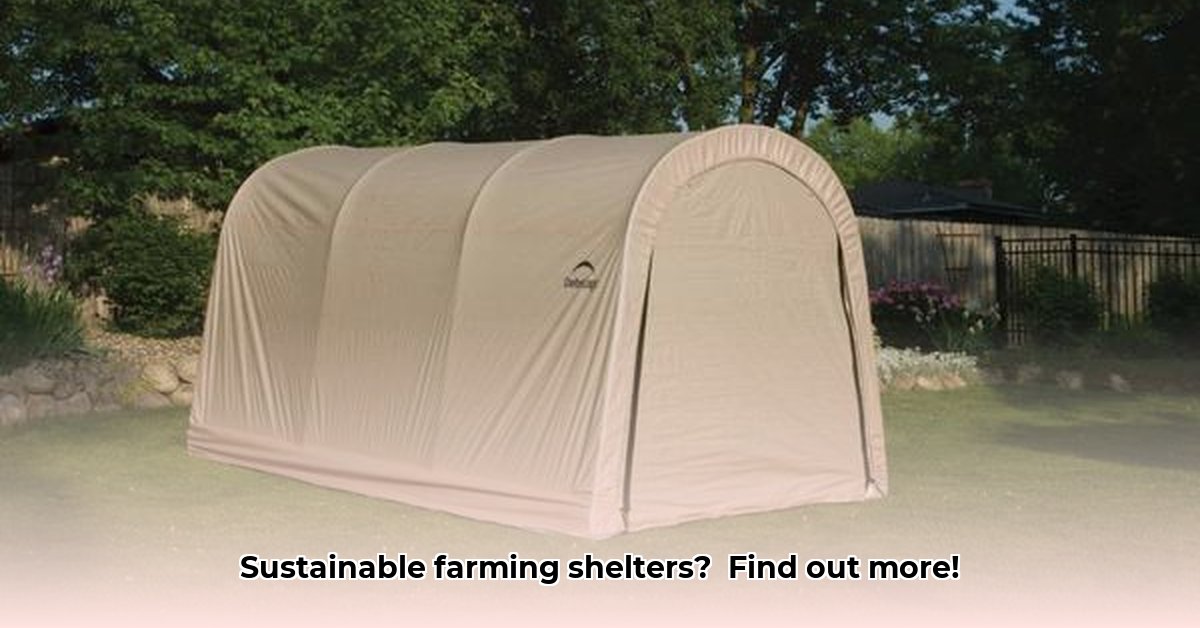
Protecting crops and equipment from harsh weather is crucial for successful farming. Durable, affordable shelters are essential for maximizing yields and minimizing losses. ShelterLogic structures, readily available at Tractor Supply, offer a range of options for farmers seeking protection. But how do these compare to other shelter types in terms of cost-effectiveness and environmental impact? For more shelter options, check out this helpful resource: Tractor Sheds. This article provides a comparative analysis to help you make an informed decision.
Comparing Shelter Options: Finding the Right Fit for Your Farm
Choosing the right shelter requires careful consideration of several factors. ShelterLogic offers various structures at Tractor Supply, but how do they stack up against polytunnels, high tunnels, and hoop houses? The ideal choice depends on your specific needs, climate, and crop type. This comparison highlights key differences in initial investment, maintenance, lifespan, and environmental impact.
To make a sound decision, consider these critical factors: initial cost, maintenance expenses, lifespan, wind and snow resistance, UV resistance, materials used, ease of assembly, suitability for different crops and climates, environmental impact, and recyclability. A comprehensive approach requires weighing these aspects together to determine the best option for your farm.
| Feature | ShelterLogic (Tractor Supply) | Polytunnels | High Tunnels | Hoop Houses |
|---|---|---|---|---|
| Initial Cost | Moderate ($300-$2000+ depending on size and features) | Low to Moderate | Moderate to High | Low |
| Maintenance Costs | Low | Low | Moderate | Low |
| Lifespan | Moderate (5-10+ years with proper care) | Moderate (5-10 years) | High (10-20+ years) | Moderate (3-7 years) |
| Wind/Snow Resistance | Moderate to High (model dependent) | Moderate to Low (design dependent) | High (design dependent) | Low |
| UV Resistance | Moderate to High (material dependent) | Moderate (material dependent) | Good (material dependent) | Low (material often degrades quickly in sun exposure) |
| Materials | Primarily polyethylene plastic (environmental impact requires further research) | Polyethylene film | Galvanized steel frame and polyethylene film | PVC pipes and polyethylene film |
| Ease of Assembly | Relatively Easy | Easy | Moderate to Difficult | Easy |
| Suitability | Varies widely by model and climate. | Versatile, suitable for specific crops and climates | Very versatile; suitable for various crops and climates | Ideal for smaller operations and warmer climates |
| Environmental Impact | Moderate (material sourcing and disposal require further research) | Low to moderate (plastic disposal) | Moderate to High (steel and wood sourcing) | Low to moderate (plastic disposal) |
Important Note: This table offers a general comparison. Always consult specific product details and specifications before purchasing.
Making it Work: A Collaborative Approach to Sustainable Shelters
Optimizing the sustainability and affordability of agricultural shelters necessitates a collaborative effort among farmers, manufacturers, suppliers, and researchers.
1. For Farmers: Explore all available financing options. Consider government grants, low-interest loans, and crop insurance programs to alleviate the initial financial burden of purchasing a shelter. Prioritize shelters with long lifespans to minimize long-term costs.
2. For Manufacturers: Prioritize transparency regarding material sourcing and environmental impact. Focus on modular designs adaptable to diverse farm sizes and climates. Incorporate more recycled and biodegradable materials whenever possible.
3. For Suppliers (like Tractor Supply): Offer bundled packages including shelters and essential accessories. Provide streamlined purchasing processes for farmers. Clearly highlight sustainable options and their advantages.
4. For Researchers: Conduct comprehensive lifecycle assessments to compare shelters across various metrics. This includes analyzing material sourcing, manufacturing processes, usage, and disposal. Studies should quantify the environmental impact and the benefits on crop yields. This research will be vital in filling the information gaps highlighted earlier.
The Bigger Picture: Future Research and Unanswered Questions
Critical areas requiring further investigation include:
- Material Sourcing Transparency: Complete traceability of materials across the supply chain is imperative to fully understand environmental impacts.
- Comprehensive Lifecycle Assessments (LCAs): Thorough LCAs allow for accurate comparisons of different shelter options and identification of improvement areas.
- Comparative Studies: More comprehensive and standardized studies directly comparing ShelterLogic products with other options are needed.
Addressing these research gaps will allow for more environmentally responsible and economically viable farming practices. This ultimately benefits farmers, manufacturers, suppliers, and the environment. The need for transparent and reliable data is paramount.
Key Takeaways
- Sustainable farming demands durable, cost-effective shelters.
- ShelterLogic provides options at Tractor Supply, but careful comparison is needed.
- Lifecycle costs and environmental impact vary significantly.
- Material selection is crucial for long-term sustainability.
- Farmers must consider their specific needs and climate.
- Further research is essential to refine lifecycle analyses and provide clearer guidance.